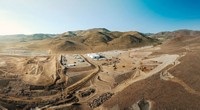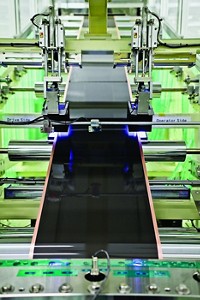Advertisement
Grab your lab coat. Let's get started
Welcome!
Welcome!
Create an account below to get 6 C&EN articles per month, receive newsletters and more - all free.
It seems this is your first time logging in online. Please enter the following information to continue.
As an ACS member you automatically get access to this site. All we need is few more details to create your reading experience.
Not you? Sign in with a different account.
Not you? Sign in with a different account.
ERROR 1
ERROR 1
ERROR 2
ERROR 2
ERROR 2
ERROR 2
ERROR 2
Password and Confirm password must match.
If you have an ACS member number, please enter it here so we can link this account to your membership. (optional)
ERROR 2
ACS values your privacy. By submitting your information, you are gaining access to C&EN and subscribing to our weekly newsletter. We use the information you provide to make your reading experience better, and we will never sell your data to third party members.
Energy
Battery Thrills And Chills
U.S. manufacturers will need more than stimulus money to succeed at powering the electric car revolution
by Melody Voith
May 4, 2009
| A version of this story appeared in
Volume 87, Issue 18

EVEN IN these tough times, good news can be stressful. A $2 billion windfall of federal stimulus money for battery manufacturing has made its likely recipients take a hard look at their industry's shortcomings.
Last month, a host of battery firms, lobbyists, government agency representatives, and chemical and materials suppliers gathered in Washington, D.C., to discuss the prospects for a U.S.-based battery industry. They reveled in their good fortune but worried that they may miss a big new market.
The $2 billion for advanced battery manufacturing is part of the renewable energy funding in the American Recovery & Reinvestment Act of 2009. It includes $275 million for facilities that supply battery raw materials. To get the money, manufacturers must submit their proposals by May 19. The projects are also likely to qualify for government loan guarantees in addition to state grants and tax incentives.
Even before the conference started, two issues had already been settled. "Advanced batteries" is code for lithium-ion technology. And the product destination for any stimulus money is not laptops or power tools but plug-in hybrid electric vehicles (PHEVs).
In case there was any doubt, the Department of Energy, keeper of the battery money, has titled this the "Electric Drive Vehicle Battery & Component Manufacturing Initiative." And David Howell, DOE's acting team leader for hybrid and electric systems, told the group that "lithium ion represents the most promising chemistry for PHEVs because of its high energy density and potential for longer life and lower cost."
So far, the promise of stimulus funds, plus tax incentives from Michigan, has tempted four battery makers—Johnson Controls-Saft Advanced Power Solutions, LG Chem, KD Advanced Battery Group, and A123Systems—to propose the construction of plants in that state (C&EN, April 20, page 9).
The real opportunity, however, is not just for fast-moving battery makers to build factories in the U.S., but for U.S. manufacturers to own the largest share of the global PHEV battery industry.
The presentations made clear that a new generation of lithium-ion cells—based on new chemistry—will power tomorrow's auto industry. The speakers said there is no reason the U.S. can't be the first to develop and make them commercially. However, China, South Korea, and Japan lead the world in making cheap cell phone and laptop batteries and are ahead in manufacturing know-how.
But for now, no region of the world is a sure bet to lead the electric car battery market. To reach commercial viability, the U.S. needs to do more than scale up manufacturing. Producers will need significant chemical and materials innovations to bring costs down and make batteries that can compete on quality, consistency, and safety.
But a cost and quality gap keeps pushing PHEVs into the future. Fans of the Toyota Prius were disappointed to learn that the third generation of the hybrid, to be released this spring, will not be the plug-in version originally promised. The issue is clearly the battery. It's not clear whether the main problem is cost, weight, or overheating.
Meanwhile, General Motors is still readying the Chevy Volt PHEV for a November 2010 launch. GM chose South Korea's LG Chem and its U.S. subsidiary Compact Power to supply the lithium-ion battery packs. The automaker has not disputed rumors that the Volt will cost $40,000. GM clearly expects consumers to pay a huge surcharge to plug their car into an electrical socket.
At the conference, battery maker EnerDel displayed a lithium-ion battery pack it designed for a future version of the small electric cars made by the Norwegian company Think. The preproduction version of the pack costs about $25,000 apiece to make.
THE ONLY CARS tooling around today's highways with lithium-ion batteries are those made by California's Tesla Motors. The all-electric Tesla is a muscular sports car that gets up to 244 miles on a single charge. But the base model costs $92,000.
The conference speakers emphasized that 70–80% of the cost of lithium-ion batteries comes from the materials. Producers can't bring down costs through cheap labor or skillful large-scale manufacturing. The task calls for breakthrough chemistry that is much more efficient. That means, among other things, less lithium; each Tesla requires an estimated 50 lb of the stuff.
Better chemistry is also essential to ensure the batteries do not overheat and fail, or worse, explode. Battery makers claim that sophisticated monitoring and software will overcome this annoying problem, but an inherently safer battery would be better.
U.S. researchers made the earliest advances in lithium-ion energy storage, but when it came time to make phone and laptop batteries, domestic companies could not compete on cost. Now, the country has a second chance at a time when manufacturing jobs are sorely needed. But it will require technological innovations and long-term federal support to build a new domestic industry.
The U.S. needs to keep in mind that China, Japan, Germany, and South Korea are also spending money to grab this prize. There is no doubt that the future of the auto industry is electrification. Yet if foreign companies jump ahead of the U.S. again by making cheaper and safer batteries, then that is what carmakers will buy.
Views expressed on this page are those of the author and not necessarily those of ACS.




Join the conversation
Contact the reporter
Submit a Letter to the Editor for publication
Engage with us on Twitter